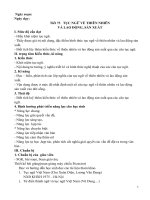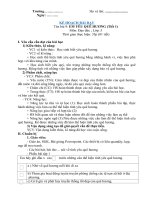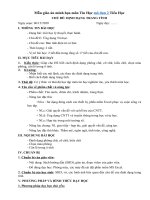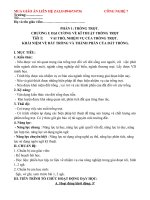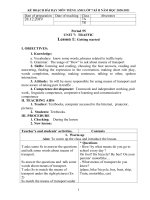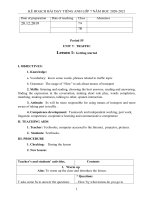Giáo án tiếng anh 7 sách global success (kì 1) chất lượng
Bạn đang xem bản rút gọn của tài liệu. Xem và tải ngay bản đầy đủ của tài liệu tại đây (4.3 MB, 198 trang )
Date of planning: 28/8 / 2022
Date of teaching : 08/8 / 2022
WEEK : 1
INSTRUCTIONS FOR USING TEXTBOOKS, STUDYING
MATERIALS
I. OBJECTIVES: By the end of the lesson students will be able to gain the
following things:
1. Knowledge:
- To introduce new Tieng Anh 7 textbooks. Student’s book and Workbook
- Tell students something about Great Britain; England and English. Students
learn how to study English well and know the way to learn English.
*Vocabulary: Use lexical items related to text book, and the way to learn
English in class; at home... some classroom languages.
* Grammar : to be; present simple tense; present continuous…
2. Competence: Students will be able to know how to study English effectively
and how to use new Tieng Anh 7 textbooks and know the methods to study
new Tieng Anh 7 textbooks.
- Be collaborative and supportive in pair work and teamwork.
- Actively join in class activities
3.Qualities: To teach Ss the love of English; The awareness about importance
of learning English. Developing self-study skills.
II. TEACHING AIDS:
- Teacher: Grade 7 text book, laptop, projector / TV/ pictures and cards.....
- Students : Text books, studying equipment….
- Computer connected to the Internet.
- Sach mem.vn
III. PROCEDURE:
1. WARM UP & INTRODUCTION ( 3’- 5’)
Aims:
1
- To create a friendly and atmosphere in the class before the lesson;
- To give T and Ss a chance to introduce themselves;
- To lead into the unit
* Content: Have some warm-up activities to create a friendly and relaxed
atmosphere to inspire Ss to warm up to the new class.
* Outcome: Having a chance to speak English and focus on the topic of the
lesson..
* Organisation: Teacher’s instructions…
Teacher’s & Student’s activities
Content
+ Greeting
+ Greeting
+ Chatting
+ Chatting.T_Ss
- Teacher (T) introduces himself/ herself
- T may introduce some warm-up activities to
creat a friendly and relaxed atmosphere to
inspire Ss to warm up to the new class…
- Students (Ss) listen and
learn how to introduce
themselves.
- Have Ss to introduce themselves.
- Introduce themselves
- T encourages Ss to talk in English as much as (name; age; address; likes;
dislikes ….friends… )
possible
+ Lead to the first unit of the new school year.
- Write the unit title on the board and ask Ss
guest what they are going to learn this unit …
+ Students (Ss) listen and
learn how to do the tasks.
- Answer the teacher’s
questions
- Ask Ss to open their book and introduce what
- Open their book and write .
they are going to study….
2. NEW LESSON (12’-15’)
ACTIVITY 1+ 2:
Aims: - To set the context for the introductory;
- To introduce the topic of the unit, the vocabulary, and the grammar
points to be learned.
* Content: Some brief notes; Something about England, English . Introduce
New Tieng Anh 7
2
* Outcome: Ss learn something about England, English; Learn how to use
New Tieng Anh 7
* Organisation: Teacher’s instructions….
Teacher’s & Student’s activities
Content
1. T. asks sts some questions about England.
- What do you know about England?
- T. gives sts something about England and
English.
- It located in North-west coast of Europe with
very mild weather not too hot but not too cold.
- It consists of four parts: England, Wales,
Scotland and Ireland.
- T_Ss
- Listen carefully and read
aloud.
- Fulfill teacher’s
requirements
- Give the answers
- It’s official name is the UK
- Ss answer if possible
- Each part has its own flag of UK.
2. English:
- Listen carefully and read
aloud.
- How many people speak English as their
mother tongue?
- Find out the words related
to the topic.
- How many people speak English as their first - There are many interesting
language?
things of England and you’ll
gradually know about them
- How many people speak English as their
in the progress of learning
second language or first foreign language?
English.
- Why do you learn English?
2/ Introduction: English is
- Is it important? Difficult? Useful?
an international language.
Interesting?
Hundreds of million people
=> It’s very important, useful, interesting. It is speak English in the world.
the means of communication to one another.
400 million people speak
English as their first
3/ New English 7 text book:
language, 600 million people
- How many units are there in English 6 text
speak English as their
book?
second language or first
- What are they about?
foreign language. 4/5 of the
3
There are 12 main units in the Student's Book.
Each unit has seven sections and provides
language input for seven classroom lessons of
45 minutes each...At the beginning of each
unit, there are explicit learning objectives that
clearly state the main language points and
skills to be taught in the unit.
world’s computers use
program in English. ¾ of all
international correspondence
is in English.
- Section 1 : GETTING STARTED.
- Each unit has 7 lessons.
3/ English 6 has 12 Units.
- T_Ss
It begins with a conversation followed by
activities which introduce the topic of the unit.
It then presents the vocabulary and the
grammar items to be learned and practised
through the skills and activities of the unit.
- Section 2 : A CLOSER LOOK 1 .
This section presents and practises the
vocabulary and pronunciation of the unit. The
active vocabulary of the unit is given in an
interesting and illustrated way so that it is easy
for students to memorise. Two sounds, which
appear frequently in the unit, are given and
practised in isolation and in context. Stress
pattern of two-syllable words, three-syllable
words, and rising and falling intonation for
questions are also dealt with in the last units of
the book. There are different exercises
focusing on intensive practice of vocabulary
and pronunciation.
- Section 3 : A CLOSER LOOK 2 .
- Section 5 : SKILL 1 .
READING AND
SPEAKING. Reading
This section aims to develop
students' reading abilities.
The reading text is often
based on the vocabulary and
structures that students have
previously acquired to make
the activity achievable..
This section deals with the main grammar
point(s) of the unit. The new language point(s)
taught in this section is / are already introduced
in Getting Started. The exercises are well
illustrated to help students remember and use
the grammar items effectively. The Speaking
Remember! boxes appear wherever necessary This section aims to provide
4
to give the rules or explanations and help further practice to support
students avoid common errors.
students in their spoken
English....
- Section 4: COMMUNICATION.
This section is designed to help students use
functional language in real life contexts and
consolidate what they have learnt in the
previous sections. It also gives students
opportunities to learn and apply the cultural
aspects of the language learnt to their lives and
provides cultural information about Viet Nam
and other countries.
- Section 6 : SKILL 2:
LISTENING AND
WRITING.
Listening
The
listening
activity
follows the oral practice in
the Speaking section. It
provides students with an
Everyday English in this section gives students opportunity to listen to the
the skills to communicate effectively in language that they have
various everyday situations...
practised orally, and trains
them to listen for general
and specific information.
Writing
This section focuses on
developing students'writing
skills. It normally involves
one of the text types
required for students' skill
development.
- Section 7: LOOKING
BACK & PROJECT.
Looking Back recycles the
language from the previous
sections and links it with the
unit topic. Its activities and
exercises are designed to
help students consolidate
and apply what they have
learnt in the unit. Teachers
can use this section to
evaluate
their
students'
5
performance and provide
further practice if necessary.
The Project activity helps
students
improve
their
ability
to
work
independently and in a team.
It extends their imagination
in a field related to the unit
topic.
* English is not too difficult
but it requires you hard
working.
- Ss need learn by heart all
vocabulary and their usage.
- Review the lesson
everyday.
- Learn English everyday.
3. PRACTICE (15’)
ACTIVITY 3:
Aims: To help Ss understand the lesson. Class room language
* Content: Some brief notes; Something about England, English . Classroom
language…
* Outcome: Ss learn something about England, English; Classroom
languages…
* Organization: Teacher’s instructions….
Teacher’s & Student’s activities
Content
3. How to learn English best?
- Tell us how you learn best?
- T_Ss
- Tell us how you can learn English best?
- Listen carefully
* Some useful classroom languages:
- Who is the monitor?
- Practice saying classroom
6
- Who is absent today?
languages.
- Who is on duty today?
- May I go out?
- Work in groups; in pairs;
present the projects….
- May I come in?.......
- How to improve your English:
- Listen to the teacher carefully, learn E. from
many sources, always enrich your vocabulary,
do exercises carefully, practice speaking,
listening, writing, reading every day. …
- Ss should work hard every day to improve
their English.
“ Hard work is the key to success”
4. PRODUCTION/ FURTHER PRACTICE (8’)
ACTIVITY 4:
Aims: To revise / teach classroom languages.
* Content: Some brief notes; Something about England, English . Classroom
languages…
* Outcome: Ss know something about England, English; Classroom
languages…
* Organization: Teacher’s instructions…..
Teacher’s & Student’s activities
Content
- T_Ss
- The greetings : - T gives some questions to introduce the class Goodmorning
expressions.
- Good
afternoon
- Have Ss listen and repeat.
- Teacher says “ go out, please” Go out
- Teacher says “No”
Don’t go out
- Call on some pairs to practice in front of the
class.
- Good
morning
- Good bye
….
- We can say “ May I go out”
- You can say “Stand up,
7
please.
- Listen, please
- Read after me
- Repeat please…..
5. WRAP-UP & HOMEWORK (2’)
* Instruct/ guide students to do their homework.
- Prepare textbook, workbook, exercise book,
* HOME WORK
- Learn classroom languages.
- Prepare new lesson Unit one My hobbies.
==============================
Date of planning:28/ 8/ 2022
UNIT 1: HOBBIES
Date of teaching: 9/ 9/ 2022
Period 2:Lesson 1: GETTING STARTED
My favourite hobby
I. OBJECTIVES:* By the end of this unit, students will be able to gain
the following things:
- use the words related to hobbies and verbs of liking and disliking to talk
about different hobbies;
- pronounce the sounds /ә/ and /з:/ correctly.
- use present simple tense;
- talk about likes and dislikes;
- read for specific information about hobby;
- talk about the benefits of hobbies;
- listen for specific information about one’s hobbies;
- write a paragraph about one’s hobby.
1. Knowledge:
- To introduce topic of the lesson Hobbies. An overview about the topic
8
Hobbies. To practice listening and reading.
+ Vocabulary:Use the words related to the topic Hobbies. Pronouncing the
sounds /ә/and/з:/correctly;
- New words: unusual (adj) ; creativity (n) ; dollhouse (n) ; cardboard (n) ;
glue (n) ; making models. horse riding, upstairs, amazing ....
+ Grammar:- Review Present simple tenses
2. Competence:Students will be able to practice listening and reading the
conversation between Trang and Ann about Hobbies;
- Develop communication skills and creativity.
- Be collaborative and supportive in pair work and teamwork.
- Actively join in class activities.
3. Qualities:- Love talking about their hobbies. Having benefits of their
hobbies in daily life. Ss have the good attitude to working in groups,
individual work, pair work, cooperative learning.
II. TEACHING AIDS:
- Teacher: Grade 7 text book, laptop, projector / TV/ pictures and cards.....
- Students : Text books, studying equipment….
- Computer connected to the Internet.
- Sach mem.vn
III. PROCEDURE:
Notes:In each activity, each step will be represented as following:
* Deliver the task.
* Implement the task.
* Discuss.
* Give comments or feedback.
1. WARM UP & INTRODUCTION ( 3’- 5’)
Aims:
- To create an active atmosphere in the class before the lesson;
- To lead into the new unit
9
* Content: Tohave somewarm-up activities to create a friendly and
relaxed atmosphere to inspire Ss to warm up to the subject and new lesson.
* Outcome: Introducing themselves to make more new friends.
* Organization : Teacher’s instructions …
Teacher’s Student’s activities
+ Greeting
+ Asking question:
- T may introduce some warm-up
activities to create an active atmosphere to
inspire Ss to warm up to the subject and
new lesson…
* Ss answer the question individually.
* T sets the context for the listening and
reading text: Write the title on the board
My favorite hobby.
* Ask Ss to guess what the conversation
might be about.
- Before open their books, T asks Ss what
they like doing for pleasure in their free
time. Summarize Ss’s answers and ask
them what these activities called.
Content
+ Greeting + Asking
question:
- T_Ss
- Asking question:
* T asks Ss about what they
like doing for pleasure in their
free time.
What do you like doing in
your free time?
Do you like collecting dolls?
Do you like collecting glass
bottles?
Do you enjoy mountain
climbing?
- Elicit the word “Hobbies”
- Write the unit title on the board My
Hobbies ..
- Ask Ss to open their book and start the
lesson.….
+ Students (Ss) listen and
learn how to do the tasks.
- Answer the teacher’s
questions.
- Open their book and write .
10
2. PRESENTATION/ NEW LESSON ( 12’- 15’)
ACTIVITY 1:
Aims: - To set the context for the introductory conversation;
- To introduce the topic of the unit, the vocabulary, the sounds, and the
grammar points to be learned.
* Content: Learn some new words in context . Read the conversation and
find out new words.
* Outcome: Practice readingthe conversation Knowing more new words.
Understanding the conversation; topic of the lesson, grammar points…
* Organisation :
Teacher’s Student’s activities
Content
1. Listen and read: /P. 8
1. Listen and read./ P. 8
+Ask Ss to open their book and start the
lesson.
- T_Ss
*Teach vocabulary:
+ Teacher uses different techniques to
teach vocab (situation, realia, translation.)
- Listen carefully to the
context
* Vocabulary
- unusual (adj)
thường
+ Teacher explains the meaning of the new
- creativity (n)
vocabulary by pictures.
tạo
+ Follow the seven steps of teaching
- dollhouse (n)
vocab.
bê
+ Check vocabulary: R & R
- cardboard (n)
+ Take note
tông
+Ask Ss to look at the pictures on page 8- - glue (n)
9 and answer the questions below:
hồ
1. Can you guess who they are?
khác
sự sáng
nhà búp
bia các
keo dán,
2. What can you see in the picture ?
- making models. làm mơ
hình
3. What hobby do they have? ....
- upstairs (n):
ở trên lầu; ở
11
+ T introduces the two characters: Trang
tầng trên
and Ann. Explain they are friends. Quickly - amazing (adj):làm sửng
write Ss’s answers to questions 2-4 on the sốt,làm ngạc nhiên
board.
- horseriding(n) cưỡi ngựa
- Play the recording twice for the Ss to
listen and read along.
- Listen carefully and read
- Have Ss underline the words that are
related to the topic of the units while they aloud.
are listening and reading.
- Invite some pairs of Ss to read the
conversation aloud.
- Now refer to the questions 2-4on the
board. Confirm the correct answers.
-(Question 2: a girl with a dollhouse; a
dollhouse. And a girl riding a horse.
- Question 3: Trang’s hobby is building
dollhouses and Ann’s hobby is horse
riding)
- Have Ss say the words in the text that
they are related to the topic My hobbies.
- Quickly write the words on one part of
the board.
- Comment on Ss’ answer.
3. PRACTICE ( 15’)
ACTIVITY 2:
Aim:To help Ss understand the conversation.
* Content: Listen and read the conversation.True/ False activity.
* Outcome: Know more new words. Understanding the conversation;
topic of the lesson, vocab.
* Organisation :
Teacher’s Student’s activities
Content
12
2. Read the conversation again and
write T (True) or F (False)
- T asks Ss to ask the sentences and decide
if they are true of false without reading
conversation again. Allow them to share
their answers with a partner before
discussing as a class.
- Ss may read the conversation again to
confirm their answers before giving T the
answers.
- Elicit from Ss. Have them correct the
false sentences.
- Write the correct answers on the board.
2. Read the conversation
again and write T (True) or
F (False).
- T_Ss . Work
independently.
- Give the answers
* Key :
1. F(she made it herself)
2. T
3. T
4. T
5. F(Her lesson starts at 8
a.m)
ACTIVITY 3:
Aim: To introduce some vocabulary items related to hobbies.
* Content: Name the picture, then listen, check and repeat.
* Outcome: Ss understand more the use some vocabulary related to
hobbies.
* Organisation :
3. Write the words and phrases from the 3.Write the words and
box under the correct pictures. Then
phrases from the box under
listen, check, and repeat 3.
the correct pictures. Then
- Ask Ss to name the pictures.
listen, check, and repeat.
- Have Ss work individually to write the
words and phrases from the box under the
correct pictures.
- T_ Ss
- Have them compare their answers with a
partner. Then ask for Ss' answers. Quickly
write their answers on the board without
confirming the correct answers.
- Ss to work independently
- Listen to the instructions
clearly
- Copy them
13
- Have Ss listen to the recording, check
their answers and repeat the words /
phrases.
- Ask Ss to look at the answers on the
board and say if they are right or wrong.
- Confirm the correct answers.
* Key:
- Have some Ss practise saying the words
and phrases again.
1. making models
horse-riding
2.
3. collecting coins
4.Gardening
5. building dollhouses
6.collecting teddy bears.
ACTIVITY 4:
Aim:To help Ss categories hobbies.
* Content: To work in pairs. Write the hobbies in the suitable column.
* Outcome: Ss know how to categorize hobbies in the suitable column.
* Organisation :
4.Work in pairs. Write the hobbies from 4. Work in pairs. Write the
3 in the suitable columns.
hobbies from 3 in the
- Have Ss work in pairs and complete the suitable columns.
table.
- Pair work
- Ss work in pairs and complete the table.
- Ss do themselves
- Teacher allows students to share answers * Suggested answers:
before discussing as a class.
- doing things: horse riding,
- Write their answers on the board.
gardening (others: travelling,
skiing, doing yoga, etc.)
- Have Ss add more words to the table
- making things: making
models, building dollhouses
(others : painting, making
14
pottery, etc.)
- collecting things: collecting
coins, collecting teddy bears
(others: collecting toys,
collecting books, etc.)
4. PRODUCTION/ FURTHER PRACTICE ( 8’)
ACTIVITY 5:
Aim:To help Ss practice using the vocabulary items related to hobbies.
* Content: Play game.Ask their classmates which hobbies they like.
* Outcome: Ss can ask and answer the hobbies they like
* Organisation :
Teacher’s Student’s activities
Content
5.GAME: Find someone who
5.GAME:Find someone who
Work in groups. Ask your classmates Work in groups. Ask your
which hobbies they like. Use the classmates which hobbies
question : Do you like ..?
they like. Use the question :
- Set time (3 - 5 minutes) for Ss to do this Do you like ..?
activity.
- Then ask the classmates around to
complete the table, using the questions 'Do
you like...?'
The student who completes the table first
wins.
- He / She reads aloud the names they
have.
5. WRAP-UP & HOME WORK (2’)
* Ask one or two Ss to tell the class what they have learnt.
- Ask Ss to say aloud some words they remember from the lesson.
15
* HOME WORK
- Read again the conversation on page 8.
- Do more exercises in workbook.
- If there is a projector in the classroom, then T should show the
conversation and highlight the key words related to the topic. It would be
helpful if T also highlights in the conversation the present simple tense and
the words with the sounds /ә/and/з:/, and tells Ss that they will learn these
language points in the upcoming lessons.
=========================
Date of planning:28/8/2022
Period 3 :UNIT 1 : HOBBIES
Date of teaching: 10/ 9/ 2022
Lesson 2 : A CLOSER LOOK - 1
WEEK: 1
I. OBJECTIVE: By the end of this lesson, students will be able to gain
the following things :
1. Knowledge:
- To introduce topic of the lesson My hobbies.. To teach some new words .
+ Vocabulary: Using the words related to hobbies ;Verbs of liking and
disliking
+ Coins, judo,jogging, yoga ; making models;
- Do judo, yoga (karate, exercise...); Go jogging, swimming (camping,
cycling..); Collect dolls, coins (books, watches, pencils ....)
+ Pronunciation: Correctly pronounce words that contain the sounds /ə/ and
/ɜ:/
+ Grammar: - The use of like, love, enjoy, hate + V-ing; talking about likes
and dislikes.
2. Competence: Students will be able to learn how to use some new words.
Know how to use some action verbs go with Nouns to describe hobbies. Ss
16
may add more nouns that can go with
these action verbs.
- Develop communication skills and creativity
- Be collaborative and supportive in pair work and teamwork
- Actively join in class activities
3. Qualities:Love talking about their hobbies; having benefits of their hobbies
in daily life.
- Develop self-study skills.
II. TEACHING AIDS:
- Teacher: Grade 7 text book, laptop, projector / TV/ pictures and cards.....
- Students : Text books, studying equipment….
- Computer connected to the Internet.
- Sach mem.vn
III. PROCEDURE:
Notes:
In each activity, each step will be represented as following:
* Deliver the task.
* Implement the task.
* Discuss.
* Give comments or feedback.
1. WARM UP & INTRODUCTION (5’)
Aim:
Vocabulary
- To create an active atmosphere in the class before the lesson
- To lead into the new lesson.
* Content: Review the previous lesson.
* Outcome: Having a chance to speak English and focus on the topic of the
lesson..
* Organization :Teacher’s instructions…
17
Teacher’s & Student’s activities
Content
+ Greeting
+ Greeting
+ Asking questions:
+ Asking questions:
* Some students are invited to answer.
* Teacher asks students
some questions about the
hobbies:
* Teacher and students discuss the answers.
* Teacher introduces the lesson.
- Show some pictures of the hobbies Ss learnt
in the previous lesson. Have some say the
hobbies. Lead to this lesson which focuses on
action verbs, verbs of liking and disliking and
the sounds /ә/and /з:/.
- Ask Ss to open their book and introduce
what they are going to study….
1. What is your favorite
hobby?
2. When did you start your
hobby?
- T_ Ss
- Students (Ss) listen and
learn how to do.
- Open their book and write
.
2. PRESENTATION/ NEW LESSON (12’)
ACTIVITY 1:
- Aim : To present some action verbs go with nouns to describe hobbies.
* Content: Teach some new words, some action verbs go with nouns.
* Outcome: Ss learn how to use them . Put them in the columns correctly.
* Organisation :
Teacher’s & Student’s activities
1. Complete the word webs below with the
words from the box.
*) Pre- teach vocabulary:
Content
1. Complete the word
webs below with the
words from the box.
- Teacher uses different techniques to teach - T_ Ss
vocabulary (situation, realia, translation .....)
+ Students(Ss)listen to the
instructions carefully and
+ Teacher may introduce the vocabulary by:
learn how to do the tasks.
18
-
providing explanations of the words;
* Vocabulary
-
showing picture illustrating the word.
- coins (n)
kim loại)
tiền xu (tiền
- judo (n)
môn võ Judo
+ Follow the steps to teach vocabulary
- Repeat in chorus and individually
+ Check vocabulary: R&R
- jogging (n) chạy bộ thể
dục
- Teacher checks students’ understanding with
the “Rub out and remember” technique.
- yoga (n)
dô-ga
Sự tập luyện
+ Take note
- Have Ss read the action verbs and match
them with the suitable words. Remind them
that a verb can go with more than one word.
- Have Ss work in pairs to compare their
answers before they give T the answers.
- Check and confirm the correct answers.
Then have Ss add more words that can go
with these action verbs.
Key :
Suggested answer:
- go:jogging, swimming
(others: go camping, go
fishing, go cycling, etc.)
- do: judo, yoga (others: do
karate, do exercise, do sit- Have Ss read the Remember! box. Ask them
ups, etc.)
to make some examples with the verbs of
- collect:dolls, coins
liking and disliking.
(others: collect books,
- Check the answers as a class.
collect watches, collect
** Remember
pencils, etc.)
- Common verbs of liking and disliking are
like, love, enjoy, and hate (not like). We often
use the –ing form after these verbs.
Example:- I like gardening.
- She hates watching TV.
3. PRACTICE (15’)
ACTIVITY 2:
Aim: To help Ss practise the verbs of liking / disliking and action verbs
* Content: Complete the sentences, using the - ing form.
19
* Outcome: Ss can learm how to use verbs of liking and disliking.
* Organisation :
Teacher’s Student’s activities
2. Complete the sentences, using the –ing
form of the verbs from the box.
- Have Ss do this activity individually. Have
Ss read all the sentences carefully to make
sure they understand the sentences.
Content
2. Complete the
sentences, using the –ing
form of the verbs from
the box.
- Let them share their answers in pairs. Invite
some Ss to give the answers.
- Listen carefully and learn
how to do.
- Write the correct answers on the board.
- Give the answer
* Key:
1. collecting
2. going
3. playing 4. making 5.
doing
ACTIVITY 3:
Aim: To give further practice with verbs of liking / disliking.
* Content:Making sentences using the pictures and verbs of liking or
dislikng.
* Outcome: Ss can make sentences correctly, using the pictures.
* Organisation :
3. Look at the pictures and say the
sentences. Use suitable verbs of liking or
disliking and the –ing form.
3. Look at the pictures
and say the sentences. Use
suitable verbs of liking or
- Have Ss look at the pictures in this exercise disliking and the –ing
and say what the person / people is / are doing form.
in each picture.
- Ask them what the face in each picture
- Ss to work individually
20
means. (A sad face means ‘don't like’ and a
happy face means 'do like'.) Ask Ss to look at
the example to make sure they understand
what to do.
first
- Ss do themselves.
- Ask Ss to work in pairs to make sentences.
- Invite Ss to share their answers. Confirm the
correct answers.
- This activity can also be organised as a
competitive game. Have pairs write down the
sentences. The pair that finishes first with the
most correct answers wins.
- If there is time, invite some Ss to make
sentences about what they like or dislike
doing.
- T and other Ss give comments.
- Copy them
* Key:
1. He hates / doesn't like
doing judo.
2. They like / love / enjoy
playing football.
3. They love / like / enjoy
gardening.
4. They enjoy / like / love
collecting stamps.
5. She hates / doesn't like
riding a horse / horse riding
II. PRONUNCIATION: (10’)
/ә/and /з:/
ACTIVITY 4
Aims:- To help Ss identify how to pronounce the sounds /ә/and /з:/
- To help Ss practise pronouncing these sounds in words.
* Content:Listen and repeat , pay attention to the sounds /ә/and /з:/
* Outcome: Ss can learn how to pronounce the sounds /ә/and /з:/ correctly.
* Organisation :
Teacher’s Student’s activities
4. Listen and repeat. Pay attention to the
sounds /ә/and /з:/
- Have some Ss read out the words first. Then
play the recording for them to listen and
Content
4. Listen and repeat. Pay
attention to the sounds
/ә/and /з:/
- Listen carefully
21
repeat the words they hear.
- Listen and repeat
- Ask them to pay close attention to the two
sounds.
- Play the recording as many times as
necessary.
- Explain to Ss the difference between the two
sounds if needed.
- Tell Ss that /ә/is the same sound while
/з:/sounds like it has a soft /r/ in it.
- Invite some Ss to say some words they know
that include the two sounds.
4. FURTHER PRACTICE (8’)
ACTIVITY 5:
Aim: To help Ss pronounce the sounds /a/ and /3:/ correctly in
sentences.
* Content: Pratice saying the words pay attention to the underlined parts
* Outcome: Ss learn how to pronounce the words , the underlined parts
correctly.
* Organisation : Teacher’s instructions…
5. Listen to the sentences and pay attention
to the underlined parts. Tick (✓) the
appropriate sounds. Practise the sentences
5. Listen to the sentences
and pay attention to the
underlined parts. Tick
(✓) the appropriate
- Have Ss quickly read the sentences.
sounds. Practise the
- Now play the recording for Ss to listen to the sentences
sentences.
- T_ Ss
- Ask them to pay attention to the underlined
Answer key:
parts and tick the appropriate sounds.
/ə/
- Invite some Ss to share their answers.
- Confirm the correct ones.
- Play the recording again for Ss to repeat the
1. My hobby is
collecting dolls.
2. I go jogging every
22
sentences.
Thursday.
- Have Ss practise the sentences in pairs.
3. My cousin likes
getting up early.
- Invite some pairs to read the sentences
aloud.
- Comment on their pronunciation of the
sounds
4. My best friend has
thirty pens.
5. Nam enjoys playing
the violin.
* Key :
* Audio script - Track 5:
1. My hobby is collecting
dolls.
2. I go jogging every
Thursday.
3. My cousin likes getting
up early.
4. My best friend has thirty
pens.
5. Nam enjoys playing the
violin.
5. WRAP-UP & HOME WORK (2’)
- Ask Ss to summarise what they have learnt in the lesson.
- Have Ss look at the objectives written on the board at the beginning of the
lesson and tick the objectives they can do
* HOME WORK
- Do more exercises in workbook.
- Prepare new lesson. A CLOSER LOOK - 2/ P. 11-12
=======================================
23
Date of planning:…/....../ 2022
Date of teaching: ………..…
Period 4 :UNIT 1 : HOBBIES
Lesson 3 : A CLOSER LOOK -2
WEEK: 2
I. OBJECTIVE: By the end of this lesson, students will be able to gain
the following things :
1. Knowledge:
- To revise and teach present simple.
- To introduce topic of the lesson My hobbies.. To teach some new words .
+ Vocabulary: Using the words related to hobbies.
+ Grammar: The form and use of present simple.
- The use of the verbs of liking: like, love, enjoy, hate + V-ing; talking about
likes and dislikes.
2. Competence:Students will be able to revise and learn how to use and form
present simple tense. Further practice with present simple tense.
- Develop communication skills
- Be collaborative and supportive in pair work and team work
- Actively join in class activities
3. Qualities: Having benefits of their hobbies in daily life.
24
- Be encouraged to know more about their classmate’s hobbies
- Develop self-study skills
II. TEACHING AIDS:
- Teacher: Grade 7 text book, laptop, projector / TV/ pictures and cards.....
- Students : Text books, studying equipment….
- Computer connected to the Internet.
- Sach mem.vn
III. PROCEDURE:
Notes:
In each activity, each step will be represented as following:
* Deliver the task.
* Implement the task.
* Discuss.
* Give comments or feedback.
1. WARM UP & INTRODUCTION (5’)
Aims:
- To create an active atmosphere in the class before the lesson;
- To lead into the new lesson.
* Content: Review the previous lesson or have somewarm-up activities to
create a friendly and relaxed atmosphere to inspire Ss to warm up to the new
lesson.
* Outcome: Having a chance to speak English and focus on the topic of the
lesson..
* Organisation :Teacher’s instructions…
Teacher’s & Student’s activities
+ Greeting
+ Game:
Content
+ Greeting
Guessing game
- T divides the class into 4 teams.
+ Game:
game
Guessing
25
